Content for TS 38.305 Word version: 18.1.0
1…
4…
5…
6…
6.5…
6.7…
7…
7.3A…
7.4…
7.6…
7.11…
7.12…
8…
8.1.2.1a…
8.1.3…
8.2…
8.3…
8.4…
8.5…
8.6…
8.7…
8.8…
8.9…
8.10…
8.11…
8.12…
8.13…
8.14…
8.15…
A…
8.2 OTDOA positioning
8.2.1 General
8.2.2 Information to be transferred between NG-RAN/5GC Elements
8.2.2.0 General
8.2.2.1 Information that may be transferred from the LMF to UE
8.2.2.2 Information that may be transferred from the ng-eNB to LMF
8.2.2.3 Information that may be transferred from the UE to LMF
8.2.2.4 Information that may be transferred from the gNB to LMF
8.2.3 OTDOA Positioning Procedures
8.2.3.0 General
8.2.3.1 Capability Transfer Procedure
8.2.3.2 Assistance Data Transfer Procedure
8.2.3.2.1 Assistance Data Transfer between LMF and UE
8.2.3.2.1.0 General
8.2.3.2.1.1 LMF initiated Assistance Data Delivery
8.2.3.2.1.2 UE initiated Assistance Data Transfer
8.2.3.2.2 Assistance Data Delivery between LMF and NG-RAN node
8.2.3.2.2.0 General
8.2.3.2.2.1 LMF-initiated assistance data delivery to the LMF
8.2.3.3 Location Information Transfer Procedure
8.2.3.3.0 General
8.2.3.3.1 LMF-initiated Location Information Transfer Procedure
8.2.3.3.2 UE-initiated Location Information Delivery procedure
...
...
8.2 OTDOA positioning p. 92
8.2.1 General p. 92
In this version of the specification, only OTDOA based on LTE signals is supported.
In the OTDOA positioning method, the UE position is estimated based on measurements taken at the UE of downlink radio signals from multiple E-UTRA TPs (possibly including PRS-only E-UTRA TPs from a PRS-based TBS), along with knowledge of the geographical coordinates of the measured TPs and their relative downlink timing.
The UE while connected to a gNB may require measurement gaps to perform the OTDOA measurements from E-UTRA TPs. The UE may request measurement gaps from a gNB using the procedure described in clause 7.4.1.1. If the UE is not aware of the SFN of at least one E-UTRA TP in the OTDOA assistance data, the UE may use autonomous gaps to acquire SFN of the E-UTRA OTDOA reference cell prior to requesting measurement gaps for performing the requested E-UTRA RSTD measurements.
The UE while connected to a ng-eNB may require measurement gaps to perform inter-frequency RSTD measurements for OTDOA from E-UTRA TPs (see TS 38.133). The UE may request measurement gaps from a ng-eNB using the procedure described in clause 7.4.2.1.
The specific positioning techniques used to estimate the UE's location from this information are beyond the scope of this specification.
8.2.2 Information to be transferred between NG-RAN/5GC Elements p. 92
8.2.2.0 General |R18| p. 92
This clause defines the information that may be transferred between LMF and UE/ng-eNB.
8.2.2.1 Information that may be transferred from the LMF to UE p. 92
The following assistance data may be transferred from the LMF to the UE:
- Physical cell IDs (PCIs), global cell IDs (GCIs), and TP IDs of candidate E-UTRA TPs for measurement;
- Timing relative to the reference E-UTRA TP of candidate E-UTRA TPs;
- PRS configuration of candidate E-UTRA TPs;
- If known, the SFN timing offset between the serving NR cell and the E-UTRA assistance data reference cell.
8.2.2.2 Information that may be transferred from the ng-eNB to LMF p. 93
The following assistance data may be transferred from the ng-eNB to the LMF:
- PCI, GCI, and TP IDs of the TPs served by the ng-eNB;
- Timing information of TPs served by the ng-eNB;
- PRS configuration of the TPs served by the ng-eNB;
- Geographical coordinates of the TPs served by the ng-eNB.
8.2.2.3 Information that may be transferred from the UE to LMF p. 93
The information that may be signalled from UE to the LMF is listed in Table 8.2.2.3-1. The individual UE measurements are defined in TS 36.214.
| Information | Measurements |
|---|---|
| Downlink Measurement Results List for EUTRA TPs | Physical cell IDs |
| Global cell IDs | |
| TP IDs | |
| Downlink timing measurements | |
| Information used to compute a reference time corresponding to the downlink timing measurements to allow correlation of downlink timing measurements with motion information independently obtained from motion sensors | Delta SFN for each E-UTRA neighbour cell |
8.2.2.4 Information that may be transferred from the gNB to LMF p. 93
The following assistance data may be transferred from the gNB to the LMF:
- NR CGI and timing information of the cells served by the gNB;
- Geographical coordinates of the access points associated with each cell served by the gNB.
8.2.3 OTDOA Positioning Procedures p. 93
8.2.3.0 General |R18| p. 93
The procedures described in this clause support OTDOA positioning measurements obtained by the UE and provided to the LMF using LPP.
In this version of the specification only the UE-assisted OTDOA positioning is supported.
8.2.3.1 Capability Transfer Procedure p. 94
The Capability Transfer procedure for OTDOA positioning is described in clause 7.1.2.1.
8.2.3.2 Assistance Data Transfer Procedure p. 94
8.2.3.2.1 Assistance Data Transfer between LMF and UE p. 94
8.2.3.2.1.0 General p. 94
The purpose of this procedure is to enable the LMF to provide assistance data to the UE (e.g., as part of a positioning procedure) and the UE to request assistance data from the LMF (e.g., as part of a positioning procedure).
8.2.3.2.1.1 LMF initiated Assistance Data Delivery p. 94
Figure 8.2.3.2.1.1-1 shows the Assistance Data Delivery operations for the OTDOA positioning method when the procedure is initiated by the LMF.
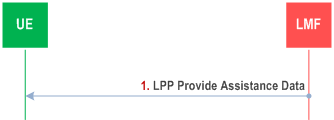
Step 1.
The LMF determines that assistance data needs to be provided to the UE (e.g., as part of a positioning procedure) and sends an LPP Provide Assistance Data message to the UE. This message may include any of the OTDOA positioning assistance data defined in clause 8.2.2.1.
8.2.3.2.1.2 UE initiated Assistance Data Transfer p. 94
Figure 8.2.3.2.1.2-1 shows the Assistance Data Transfer operations for the OTDOA positioning method when the procedure is initiated by the UE.
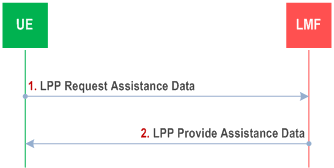
Step 1.
The UE determines that certain OTDOA positioning assistance data are desired (e.g., as part of a positioning procedure when the LMF provided assistance data are not sufficient for the UE to fulfil the request) and sends an LPP Request Assistance Data message to the LMF. This request includes an indication of which specific OTDOA assistance data are requested. Additional information concerning the UE's approximate location and serving and neighbour cells may also be provided in the Request Assistance Data message and/or in an accompanying Provide Location Information message to help the LMF provide appropriate assistance data. This additional data may include the UE's last known location if available, the cell IDs of the UE serving NG-RAN node and possibly neighbour NG-RAN nodes, as well as E-UTRA E-CID measurements.
Step 2.
The LMF provides the requested assistance in an LPP Provide Assistance Data message, if available at the LMF. If any of the UE requested assistance data in step (1) are not provided in step 2, the UE shall assume that the requested assistance data are not supported, or currently not available at the LMF. If none of the UE requested assistance data in step (1) can be provided by the LMF, return any information that can be provided in an LPP message of type Provide Assistance Data which includes a cause indication for the not provided assistance data.
8.2.3.2.2 Assistance Data Delivery between LMF and NG-RAN node p. 95
8.2.3.2.2.0 General p. 95
The purpose of this procedure is to enable the NG-RAN node to provide assistance data to the LMF, for subsequent delivery to the UE using the procedures of clause 8.2.3.2.1 or for use in the calculation of positioning estimates at the LMF.
8.2.3.2.2.1 LMF-initiated assistance data delivery to the LMF p. 95
Figure 8.2.3.2.2.1-1 shows the Assistance Data Delivery operation from the NG-RAN node to the LMF for the OTDOA positioning method, in the case that the procedure is initiated by the LMF.
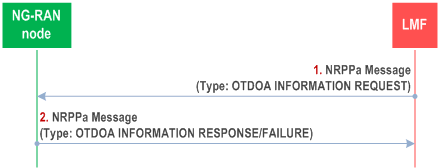
Step 1.
The LMF determines that certain OTDOA positioning assistance data are desired (e.g., as part of a periodic update or as triggered by OAM) and sends an NRPPa OTDOA INFORMATION REQUEST message to the NG-RAN node. This request includes an indication of which specific OTDOA assistance data are requested.
Step 2.
The NG-RAN node provides the requested assistance in an NRPPa OTDOA INFORMATION RESPONSE message, if available at the NG-RAN node. If the NG-RAN node is not able to provide any information, it returns an OTDOA INFORMATION FAILURE message indicating the cause of the failure.
8.2.3.3 Location Information Transfer Procedure p. 95
8.2.3.3.0 General |R18| p. 95
The purpose of this procedure is to enable the LMF to request position measurements from the UE, or to enable the UE to provide location measurements to the LMF for position calculation.
8.2.3.3.1 LMF-initiated Location Information Transfer Procedure p. 95
Figure 8.2.3.3.1-1 shows the Location Information Transfer operations for the OTDOA positioning method when the procedure is initiated by the LMF.
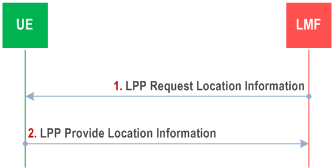
Step 1.
The LMF sends an LPP Request Location Information message to the UE. This request includes indication of OTDOA measurements requested, including any needed measurement configuration information, and required response time.
Step 2.
The UE obtains OTDOA measurements as requested in step 1. The UE then sends an LPP Provide Location Information message to the LMF, before the Response Time provided in step (1) elapsed, and includes the obtained OTDOA measurements. If the UE is unable to perform the requested measurements, or the Response Time elapsed before any of the requested measurements were obtained, the UE returns any information that can be provided in an LPP message of type Provide Location Information which includes a cause indication for the not provided location information.
8.2.3.3.2 UE-initiated Location Information Delivery procedure p. 96
Figure 8.2.3.3.2-1 shows the Location Information Delivery procedure operations for the OTDOA positioning method when the procedure is initiated by the UE.
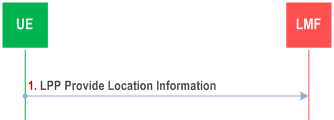
Step 1.
The UE sends an LPP Provide Location Information message to the LMF. The Provide Location Information message may include any UE OTDOA measurements already available at the UE.